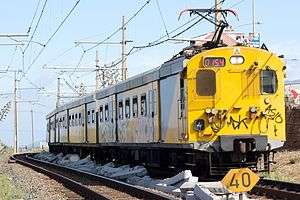South African Class 5M2
The Class 5M2 and Class 5M2A are electric multiple units that are used to provide commuter rail services by Metrorail in the major cities of South Africa. The original Class 5M2 trainsets were built for the South African Railways by Metro-Cammell between 1958 and 1960.[1] Most of those in use today, however, are of Class 5M2A,[2] built to the same design by Union Carriage & Wagon (UCW) from 1962 to 1985; a total of 4,447 coaches were built by UCW.[3]
| South African Railways Class 5M2 | |
|---|---|
 | |
| In service | 1958–present |
| Manufacturer | Metro-Cammell (5M2); Union Carriage & Wagon (5M2A) |
| Constructed | 1958–1960 (Metro Cammell); 1962–1985 (UCW) |
| Number built | 4,447 coaches (5M2A) |
| Formation | 4–14 cars per trainset |
| Capacity | Motor: 110 standing, 56 seated; Trailer: 149 standing, 52 seated |
| Operator(s) | Metrorail |
| Specifications | |
| Maximum speed | 100 km/h (62 mph) |
| Weight | Motor: 60 tonnes (59 long tons; 66 short tons); Trailer: 30.5 tonnes (30.0 long tons; 33.6 short tons) |
| Power output | 925 kW (1,240 hp) per motor coach |
| Electric system(s) | 3000 V DC Catenary |
| Current collection method | Pantograph |
| Track gauge | 3 ft 6 in (1,067 mm) Cape gauge |
Although most of Metrorail's services are still operated by 5M2As, they are being progressively rebuilt into the new Class 10M3, 10M4 and 10M5. Class 5M2A coaches are stripped down to the underframe, which is then used as the base for the Class 10Ms.[4]
Specifications
.jpg)
The Class 5M2s operate on the 3 ft 6 in (1,067 mm) Cape gauge track that is standard throughout Southern Africa. The motor coaches draw 3,000 volt direct current from an overhead pantograph; they have a power output of 925 kilowatts (1,240 hp) and produce 158 kN (15.9 LTf; 17.8 STf) of tractive effort. The maximum speed of a 5M2 trainset is 100 kilometres per hour (62 mph). A motor coach can carry 56 seated and 110 standing passengers, and has a tare weight of 60 tonnes. A trailer coach can carry 52 seated and 149 standing passengers, and has a tare weight of 30.5 tonnes (30.0 long tons; 33.6 short tons).[3]
References
- Ripley, Luke. "Eagle 61 :: A Gricer's Guide To The Railways of South Africa". Cambridge University Railway Club. Archived from the original on 17 May 2009. Retrieved 7 August 2009.
- "New Electric Stock for South Africa". Proceedings of the American Railway Engineering Association. 68: 238. 1967. Retrieved 15 September 2010.
- "Electric Multiple Units" (PDF). The UCW Partnership. Retrieved 7 August 2009.
- "Refurbishment and Upgrades - The Modular Concept". The UCW Partnership. Archived from the original on February 21, 2009. Retrieved 7 August 2009.
External links
![]()